View in other NatureServe Network Field Guides
NatureServe
Montana
Utah
Wyoming
Idaho
Wisconsin
British Columbia
South Carolina
Yukon
California
New York
Ribbed Spot Snail - Punctum californicum
Other Names:
Punctum randolphi
General Description
A very small shell, to 1.8 mm diameter and 1.2 mm in height, flattened heliciform with a moderately-raised spire, with up to 4 1/4 whorls. Shell is translucent yellowish-brown, with a series of small closely-spaced axial riblets on both surfaces; periphery rounded. The aperture is crescent shaped, broader than high; umbilicus is somewhat narrow and deep, about 1/4 the shell diameter. The body is short and barely visible beyond the shell when crawling (Hendricks 2012, Burke 2013).
Diagnostic Characteristics
The spots are very small, yellowish brown shells (less than 3.0 mm diameter) with 4.0 to 4.25 whorls, which separates them from other species. Species of Pristiloma are more tightly coiled with more whorls, slightly larger in diameter with a narrow to absent umbilicus, and lack riblets. Punctum minutissimum is flatter in profile (lower conic) with a wider umbillicus than P. randolphi though similar in diameter, P. californicum is similar in shape to P. randolphi but larger with more solid riblets, Paralaoma caputspinulae is larger still (to > 2.0 mm diameter) with rather high cuticular riblets visible under magnification but with a flatter profile like P. californicum.
Species Range
Montana Range
Range Descriptions
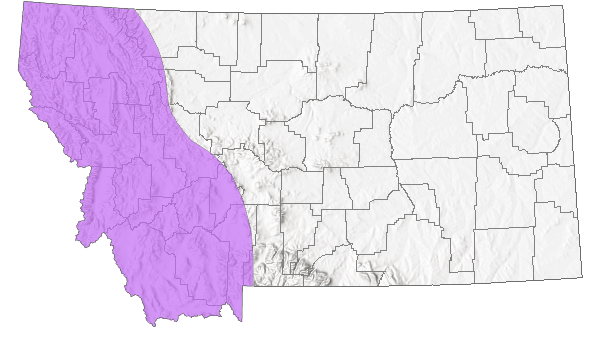
 Native
Native
Range Comments
Mostly California and Arizona, also Colorado and Montana (Burke 2013). In Montana, reported for seven counties, all but one west of the Continental Divide (tentative P. randolphi reported for two additional western counties): Flathead, Gallatin, Glacier, Granite, Lake, Mineral, Ravalli. Elevation range is 966 to 2249 m (3170 to 7380 ft). Most or all specimens of Punctum in Montana west of the Continental Divide are probably the same species (Hendricks 2012). Usually only a few individuals are encountered, but 30 were reported at one Glacier County site in late August (Berry 1919).
Observations in Montana Natural Heritage Program Database
Number of Observations: 33
(Click on the following maps and charts to see full sized version)
Map Help and Descriptions
Relative Density
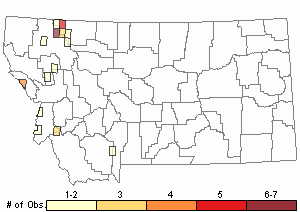
Recency
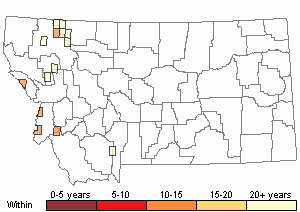
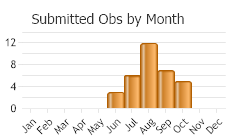
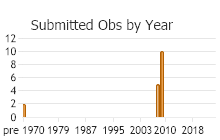
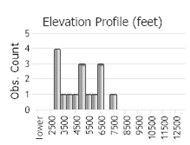 (Observations spanning multiple months or years are excluded from time charts)
(Observations spanning multiple months or years are excluded from time charts)
Habitat
Mesic mixed conifer forest. Canopy species include western redcedar, western hemlock, Engelmann spruce, subalpine fir, black cottonwood, western larch and lodgepole pine, secondary canopy includes alder, dogwood and mountain maple. Found under woody debris in leaf litter and duff in moist sites (Berry 1919, Hendricks 2012).
Stewardship Responsibility
References
- Literature Cited AboveLegend:
 View Online Publication
View Online Publication Berry, S.S. 1919. Mollusca of Glacier National Park, Montana. Proceedings of the Academy of Natural Sciences of Philadelphia 71:195-205.
Berry, S.S. 1919. Mollusca of Glacier National Park, Montana. Proceedings of the Academy of Natural Sciences of Philadelphia 71:195-205. Burke, T. E. 2013. Land snails and slugs of the Pacific Northwest. Corvallis, OR: Oregon State University Press. 344 p.
Burke, T. E. 2013. Land snails and slugs of the Pacific Northwest. Corvallis, OR: Oregon State University Press. 344 p. Hendricks, P. 2012. A Guide to the Land Snails and Slugs of Montana. A report to the U.S. Forest Service - Region 1. Montana Natural Heritage Program, Helena, MT. vii + 187 pp. plus appendices.
Hendricks, P. 2012. A Guide to the Land Snails and Slugs of Montana. A report to the U.S. Forest Service - Region 1. Montana Natural Heritage Program, Helena, MT. vii + 187 pp. plus appendices.
- Additional ReferencesLegend:
 View Online Publication
View Online Publication
Do you know of a citation we're missing? Forsyth, R.G. 2004. Land snails of British Columbia. Royal British Columbia Museum: Victoria, British Columbia, Canada. 188 pp.
Forsyth, R.G. 2004. Land snails of British Columbia. Royal British Columbia Museum: Victoria, British Columbia, Canada. 188 pp. Pilsbry, H.A. 1948. Land Mollusca of North America (north of Mexico), Volume II Part 2. The Academy of Natural Sciences of Philadelphia Monograph Number 2(2): 521-1113.
Pilsbry, H.A. 1948. Land Mollusca of North America (north of Mexico), Volume II Part 2. The Academy of Natural Sciences of Philadelphia Monograph Number 2(2): 521-1113.
- Web Search Engines for Articles on "Ribbed Spot Snail"
- Additional Sources of Information Related to "Snails / Slugs"





